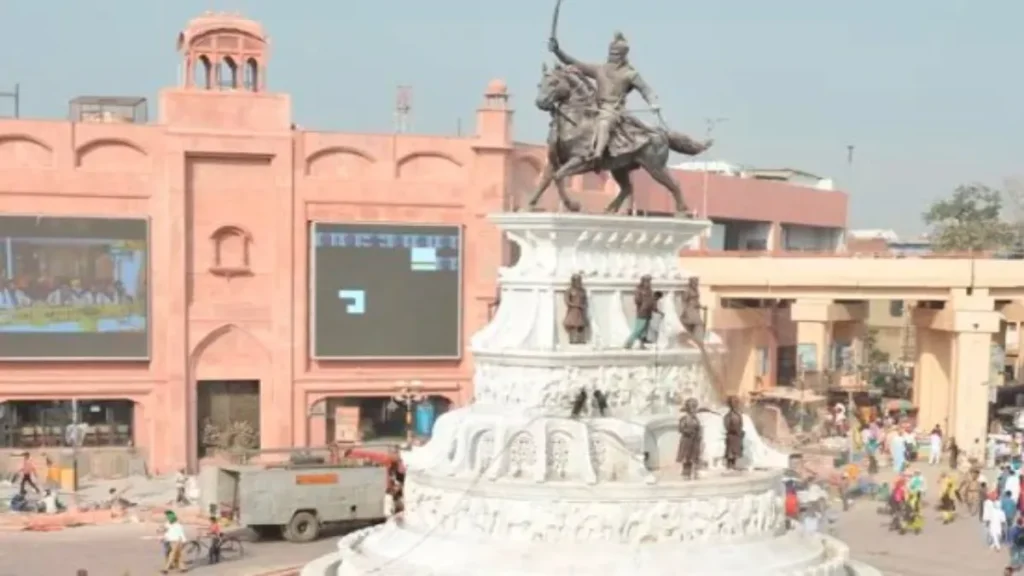Amritsar District: PUNJAB
Discover the rich history, spirituality, and cultural heritage of Amritsar District in Punjab, India. Visit the iconic Golden Temple, explore historical sites like Jallianwala Bagh, and experience the vibrant festivals and cuisine of this captivating region.

Amritsar District, located in the northwestern Indian state of Punjab, holds a prominent place in the country’s history, culture, and spirituality. Spread over an area of approximately 2,683 square kilometers, the district is renowned for housing the iconic Golden Temple, a symbol of Sikhism and a major pilgrimage site.
The city of Amritsar, which serves as the district’s headquarters, is steeped in historical significance. It was founded by Guru Ram Das, the fourth Sikh Guru, in the late 16th century. The Golden Temple, officially known as Harmandir Sahib, is the spiritual heart of Sikhism and draws millions of devotees and tourists every year. Its striking architecture, with the temple surrounded by a serene and sacred water body, exemplifies a harmonious blend of Islamic and Hindu architectural styles.
Aside from its religious importance, Amritsar District has witnessed several pivotal events in Indian history. The infamous Jallianwala Bagh massacre of 1919, a tragic incident during British colonial rule, occurred within its boundaries. This event significantly fueled the Indian freedom movement and left an indelible mark on the nation’s collective memory.
Amritsar is also known for its rich cultural heritage. The district is a melting pot of various cultures and traditions, with Punjabi being the predominant language spoken. The vibrant and colorful festivals of the region, such as Baisakhi and Diwali, are celebrated with great enthusiasm. The district’s cuisine is a gastronomic delight, featuring iconic Punjabi dishes like Amritsari kulcha, tandoori chicken, and lassi.
Economically, Amritsar plays a crucial role in the state’s growth. The city is a major trade and commerce hub, owing to its proximity to the border with Pakistan and its well-connected transportation network. Agriculture forms the backbone of the district’s economy, with crops like wheat, rice, and vegetables being cultivated extensively.
Amritsar District is also a tourist hotspot. Beyond the Golden Temple, the district boasts other attractions such as the Jallianwala Bagh memorial, Durgiana Temple, and the Partition Museum, which chronicles the history of the traumatic partition of India in 1947. The Wagah Border, where the daily flag-lowering ceremony takes place between India and Pakistan, draws crowds for its patriotic fervor.
In recent years, efforts have been made to modernize and develop the district’s infrastructure. Improved roadways, educational institutions, and healthcare facilities have contributed to the overall quality of life for its residents.
In conclusion, Amritsar District is a captivating blend of history, spirituality, culture, and economic significance. Its iconic Golden Temple, historical events, and cultural heritage make it a truly unique destination. As it continues to evolve, the district manages to preserve its rich heritage while embracing progress and development.
Famous Places in Amritsar District
Amritsar District in Punjab, India, is home to a plethora of famous places that showcase its rich history, spirituality, and cultural diversity. Some of the prominent attractions include:
Golden Temple (Harmandir Sahib): The jewel of Amritsar, this iconic Sikh shrine is known for its stunning architecture and serene environment. It attracts millions of devotees and tourists from around the world.
Jallianwala Bagh: A somber reminder of British colonial brutality, this public garden witnessed the tragic Jallianwala Bagh massacre in 1919. The memorial stands as a tribute to those who lost their lives during that dark period.
Durgiana Temple: Also referred to as the Silver Temple, this Hindu shrine is dedicated to Goddess Durga. Its architecture resembles the Golden Temple and it holds cultural and religious significance.
Wagah Border: Experience the electrifying flag-lowering ceremony at the Indo-Pak border. The lively event showcases the patriotic fervor of both nations and is a must-see spectacle.
Partition Museum: This museum provides a moving account of the partition of India in 1947. Through exhibits and stories, it offers insights into the immense human tragedy that accompanied this historic event.
Ram Bagh: Named after Guru Ram Das, the founder of Amritsar, this garden is home to the summer palace of Maharaja Ranjit Singh, the Sikh Empire’s leader. The museum within the palace displays artifacts from that era.
Khalsa College: Known for its architectural grandeur, this college was established during the early 20th century to promote Sikh culture and education. The campus showcases an impressive blend of Sikh and European architectural styles.
Gobindgarh Fort: A historic fort that has been transformed into a cultural and entertainment hub. It offers a glimpse into Punjab’s martial history and also hosts cultural performances.
Mata Lal Devi Temple: This unique temple is situated within a cave and is dedicated to the female saint Lal Devi. It is believed that tying a thread in the temple can fulfill wishes.
Maharaja Ranjit Singh Museum: Located in the Ram Bagh complex, this museum displays artifacts, weapons, and paintings from the time of Maharaja Ranjit Singh’s rule.
Gurdwara Baba Atal Rai: A beautiful nine-story Sikh shrine that commemorates the life of Guru Hargobind’s son, Baba Atal Rai.
Gandhi Gate: An architectural marvel, this gate was built in the memory of Mahatma Gandhi and stands as a symbol of India’s struggle for independence.
These famous places collectively capture the essence of Amritsar District, offering a diverse range of experiences that encompass spirituality, history, culture, and patriotism.
Read More :-